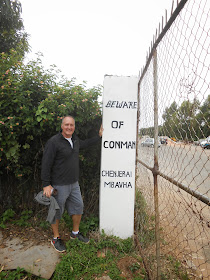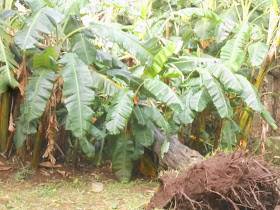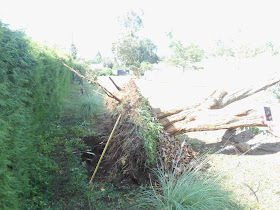Sunday, March 30, 2014
Monday, March 24, 2014
Fierce Finishes to the Rainy Season
African skies always love to pretend that nothing happened. When we awoke Friday morning, birds chirped and a bright blue diadem with puffy white clouds shined overhead. One would never guess that the night before we went through a storm I can only liken to my experience living through 2011's Hurricane Irene. Though this storm was rather quick, the clean-up will be anything but. Six days later, the sounds of chainsaws buzzing through the neighborhood are still going strong and our electrical wires still hang in mangled messes throughout the neighborhood. Sigh. We are told it could be a few weeks before our power and internet are restored. In the meantime, I will apparently be spending a lot of time at Kurt's generator-powered school.
Our neighborhood received the brunt of the storm, with downed trees blocking roads on nearly every block. WHAT a mess; we spent the day searching out petrol and groceries before watching a chainsawer spend eight hours massacre-ing 15 of our trees. Meanwhile, most people were just thankful that no one anywhere seemed to have been hurt. As we celebrate close calls and a plethora of firewood literally fallen from the sky, here are some pics of our/ our neighborhood's new challenges:











Our neighborhood received the brunt of the storm, with downed trees blocking roads on nearly every block. WHAT a mess; we spent the day searching out petrol and groceries before watching a chainsawer spend eight hours massacre-ing 15 of our trees. Meanwhile, most people were just thankful that no one anywhere seemed to have been hurt. As we celebrate close calls and a plethora of firewood literally fallen from the sky, here are some pics of our/ our neighborhood's new challenges:
Here is one of three sections of roof we are now searching for.
Anyone seen the top of our chimney?
Despite anti-burning laws in the city, from the looks of our (not even close to finished) twelve foot high pile, my guess is the neighborhood may be smokey for quite a while.

I found it surprising to find oodles of tall pine trees upon moving to Africa. The problem with them here is that their roots and the soil make for a deadly combination. These toppling giants are hazards found all throughout our neighborhoods.
We were unable to get out of our close (culd-a-sac) because of a downed tree. After learning that the neighbor whose tree it was could not pay for the removal, us (albeit trapped) neighbors all pitched together to get the bill taken care of.
Gotta find humor in the fact that the underground internet cable (above, yellow) just connected last week was pulled up by the only tree that fell on the close.


Making new roads to get to the petrol station...


Meet our (newly redone) power lines. (Surrounded by tall wobbly pines!)


Four days after this tree is still on the road… and my power lines.


(Above, right) here bamboo poles are used to get ropes high enough on our tree to pull it away from the power lines before the cutting starts.


(Above, right) Watching trees being taken down may be one of the saddest things I've ever seen. Sigh. We loved that tree... Fourteen more to go.
Sunday, March 23, 2014
The African DMV: “How did we get here?! Here??”
As our friend Julie loves to quite aptly point out, there
are moments when we look at her family and ours and say, “How did we get here?! Here.”
Surreal, strange moments have abounded for us Americans as we’ve navigated life
in Africa after growing up in a different concept of normalcy. Crazy moments. Traveling
across South Africa with all of our possessions in the trunks of three identical cars. Screaming and retreating into the house after
our mango picking was interrupted by swarms of mating termites gathering in our
hair. Cleaning dead birds out of our
kitchen sink while looking for delinquent elephants a remote three hours from
the nearest semblance of a village. Watching the aftermath of a housekeeper who
convinced Julie’s teenager to drive her to pick up a stolen bathtub when his
parents were teaching school. Just a few
weeks ago Julie and I found ourselves in a doctor’s office together, answering
each other’s questions regarding frequency of diarrhea before learning that
said doctor – who we’ve been going to for over a year- is actually a
veterinarian. And then last weekend, baking in a hot car while my four year
old, Jonas, Julie, and I banged our heads outside of the African equivalent of
a DMV (Department of Motor Vehicles) we watched a man carry a perfectly
balanced queen-sized mattress down the street on his head. “How did
we get here?! Here.”
Life is weird.
On a whim my four year old, Jonas, and I found ourselves at
the equivalent of a DMV (Department of Motor Vehicles) in the village of
Bindura, an hour north of Harare, with our friends, their 16 year old daughter
Megan, their gardener, a crowd of thirty, and a shotgun wielding guard. As
husband Kurt was living it up in a South African hotel of endless food and
actual showers, Jonas and I found ourselves easily entertained by the quirky
eccentricities of the drivers-permit testing system and a baseball and glove. And boy did we wait.
Why we thought the trip would be fast, none of us
knows.
I’ve had some long hellish experiences in the American DMV
system, so add a sprinkle of Africa into that and you have a hilarious waiting
game involving expired IDs, delayed tests, cramming from the driver’s manual,
and some great demonstrations of what not to do while taking a test drive. Though
gardener Tapiwa had taken the test twice in our city, bribery (or in his case,
a lack of) had gotten in the way. Now we
sat with Tapiwa and Megan in this small town of Bindura, surrounded by
anti-bribery signs and rifles. It would have been perfect. If Tapiwa’s ID hadn’t expired since his last
test. Megan went on to take her test,
having studied for weeks from a manual with questions like this:


 |
| (c) when reversing |
 |
| (a) adjust the mirror because obviously it's pointing at the sky |
 |
| (c) the meaning of life |
 |
| (c) reversing… because why be cautious at any other time? |
 |
| (c) no… though if the kid's eleven, all bets are off… I love how all of the true/false yes/no questions always have a weird third option. |
Most people –if they can scrape together the money- find themselves
repeating the written test over and over until their ability to reason has eventually
been tainted enough to find hidden logic in questions like the ones above. When Megan came out of the testing room, she
explained how every student’s test score was announced out loud after the
instructor corrected it with the seated class in waiting. But testers never got
to see their test again to learn what they had done wrong. So in the case of Megan, who was just a teeny
tiny two questions shy of passing, she could only guess what would have to be changed
the next time she lined up for another five hours of DMV fun.
In the end, our car of six people drove away silently, hot, hungry, deflated, and empty handed except for a few pictures of some entertaining signs, and some
special rocks Jonas had found in the midst of the driver’s test parking lot. I couldn't help but once again wonder, “How did we get
here?! Here.”


Megan and Tapiwa wait at the end of a very long early morning queue. It almost makes things seem organized, doesn't it.
Jonas looks on from the parking lot while the sun heats up.
Cramming during the wait.
A man with a rifle checks IDs before moving applicants around the corner to another queue.


I thought it would be funny, but Jonas was not so excited about getting his picture taken in front of this sign. Good thing Dan was so enthusiastic.
Thursday, March 20, 2014
Saturday, March 15, 2014
Pieces of Learning: Gender Tidbits
Some random facts about the workings of gender within our particular African culture:
-Traditional to Shona custom, a dowry is paid by the groom when a man marries a woman. Unfortunately, this can make for very long and complicated wedding days. Guests stand outside the gates or property and wait while the groom bargains and negotiates with the future father-in-law. (Even when someone is engaged for months, negotiations happen the day-of.) Things can get awkward and tense if negotiations do not go well. These negotiations can last for hours, so by the time the couple is actually married, guests are half-starved and huge celebrations are in order!
-Because a dowry is paid for a bride, there is a common attitude in Shona culture that the husband “owns” the wife, as he paid for her. Therefore, the concept of rape or abuse within marriage is not understood; a man has the ability to treat his wife as he would like. Abuse statistics in this country are shocking.
-If ever you want to see strong women, move to Africa. In traditional Shona culture, the man walks in front of the woman with his arms free to protect her. She, in turn, often carries everything. Items on her head, in her arms -and almost always- a baby on her back. Quite the amusing opposite of the well-intended chauvinism I often found when living in the Bronx- a place where every man offered to carry things for me, heavy or not!
-This
is my personal estimate, but I would say about 90% of all Shona women in the country
wear skirts. Though pants are acceptable and also accessible, the fashion
preference is clear.
-Bikes
are extremely popular among Shona as an attainable mode of transportation. Used bikes go for approximately $400 a piece
here, and new bikes are approximately $1,000.
The interesting thing is that although there are bikes everywhere, I
have never yet seen even one ridden by a woman.
It is just not done.
-It
is illegal to be gay in our country.
-It
is very common to see two grown men holding hands while walking down the
street. Hand holding does not indicate
romantic involvement in the same way it does in many Westernized countries.
-According to our Shona housekeeper, it is traditional that a Shona woman does not look her father-in-law in the eye or make conversation with him. This is a sign of respect.
-Men eat separately from women and are served by women. It is considered by manners to leave your plate/dinner place before the older men have done so.
-We
have been blessed to celebrate a few baby's births during our time in
Africa. Shona men are traditionally not
allowed at a birth. Often the baby is
born at the hospital or clinic, then the husband is called to come pick up the
wife and baby immediately or one day after. Non-gender side note: The hospital does not provide food or water for inpatients; they must have people bring those things to them if they want to eat or drink while in the hospital.
-Traditionally, when a first-time Shona mother who has
just given birth comes home, her mother stays with her for over a month. No travel is allowed for a new mother for
one month once she arrives home from giving birth.
Wednesday, March 12, 2014
Finding the Faithful
There is nothing more beautiful –magical, really- than
hearing African music rising to the clouds throughout your neighborhood as you
play with your child inside your lush yard walls.
And there is nothing more unsettling –terrifying, really-
than hearing a thousand voices screaming non-understandable words in unison so
loudly that the earth under your feet shakes.
Such is our weekly experience with the faithful in our
African city.
Church is a very cultural thing, as any person who has ever
traveled will tell you. Though people
across the world may share the same religion, chances are their cultural habits
also affect how they show their practices of worship in uniquely different
ways. Though there are many churches in
Africa, of a variety of religions and sizes, the most visible way faith is
present in our country looks like this:








(please pardon the bad photography that happens when your husband never slows down for pictures...)
You can call these communal churches. You can call these cults. You can call these small worships. But beyond being referred to in a variety of
ways, almost each of these gatherings is unique in its particular
practices. Animation is a common partner
with Christianity in many places in Southern Africa; beliefs in personified
pieces of nature, places, or animals go hand in hand with a male-led
Christianity that literally varies from street to street and field to
field. Idol worship and ancestral
tradition is often present, and the sexes are often separated for most, if not
all, of the service time.
Times of worship vary from group to group, but most
practices call followers to gather on Saturdays or Sundays. No matter whether the sun is just rising or
nearly setting, whether it is pouring or painfully hot, groups of worshipers
wearing their distinct colors are always out and about. Add in some extra enthusiasm during Christmas,
Easter, New Years, and special revival weekends, and there is rarely a day you
will not pass the prayers of the faithful as you drive along farms and fields.
When we first moved to Harare, I spent our first month
thinking we lived near a stadium. Loud
speakers, shouting, and roars of a crowd filled our yard constantly. Sometimes it was beautiful. And sometimes it was so powerful it was
unsettling, as though the chanting was out of control. We came to learn that the sounds we hear
every Saturday, and sometimes on other special days, is a church that gathers
on a field over a kilometer away.
It was actually surprising for us to learn just how many of
my husband’s students attend church every weekend. Though church-going statistics are high, you would
never know it from the small amount of formal churches to be found throughout
our neighborhoods. The church
communities that do gather inside an enclosure for worship often gather in
rented or borrowed places such as schools, libraries, and other public
buildings.
Our son Jonas has become obsessed with the churches we have
found here in Africa. There is something
about them he loves so much that he almost always screams for us to back up or
to get the camera when we pass one. Hence,
here are a few sweet little churches I can share with you:
.JPG)
.JPG)
Masvingo, Zimbabwe
Johannesburg, South Africa
This
was the sweetest looking building in a worn down neighborhood in Johannesburg,
South Africa. This teeny shack no bigger than half my living room sat in the
midst of a dirty mechanic and a razor-wired parking lot.
Mount Pleasant, Zimbabwe
JoBerg, South Africa: I took this picture haphazardly with my camera out the window just seconds before a man tried to mug us. Sort of spoiled the moment.





























